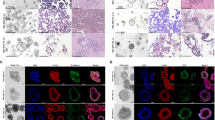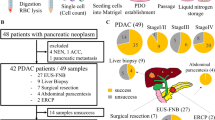Abstract
No data exist on biologic differences between Cancer of unknown primary (CUP) and metastatic solid tumors of known primary site. We assigned a primary tissue of origin in 40 favorable CUP patients (A: serous peritoneal carcinomatosis n = 14, B: axillary adenocarcinoma n = 8, C: upper squamous cervical adenopathy n = 18) by means of a 64-microRNA assay. Subsequently, we profiled the expression of 733 microRNAs (miRs) in the CUP cases and compared results with metastases from 20 ovarian carcinomas, 10 breast adenocarcinomas, 20 squamous head neck or lung tumors. In the Peritoneal CUP versus Ovarian (Known Primary Metastases) KPM comparison, a total of 12 miR were significantly differentially expressed: higher than twofold expression difference in CUP was seen only for miR-513a-5p (3.7-fold upregulated) and miR-483-5p (2.5-fold upregulated), while miR-708 exhibited a twofold downregulation. In the Breast CUP versus Breast KPM comparison, only miR-29c that were downregulated in CUP by 2.7-fold satisfied the FDR threshold. miR-30e and miR-27b, downregulated in ovarian CUPs versus KPMs, were also non-significantly downregulated in breast CUP by 2.0- and 1.4-fold respectively. Six miRs, which belong to the 17–92 oncocluster showed a trend of upregulation in Breast CUP versus Breast KPM cases. A CUP signature remains elusive.



Similar content being viewed by others
References
Pavlidis N, Pentheroudakis G (2012) Cancer of unknown primary site. Lancet 379:1428–1435
Pentheroudakis G, Briasoulis E, Pavlidis N (2007) Cancer of unknown primary site: missing primary or missing biology? Oncologist 12:418–425
Monzon FA, Koen TJ (2010) Diagnosis of metastatic neoplasms: molecular approaches for identification of tissue of origin. Arch Pathol Lab Med 134:216–224
Pavlidis N, Petrakis D, Golfinopoulos V, Pentheroudakis G (2012) Long-term survivors among patients with cancer of unknown primary. Crit Rev Oncol Hematol 84(1):85–92
Pentheroudakis G, Stoyianni A, Pavlidis N (2011) Cancer of unknown primary patients with midline nodal distribution: midway between poor and favourable prognosis? Cancer Treat Rev 37:120–126
Pentheroudakis G, Pavlidis N (2010) Serous papillary peritoneal carcinoma: unknown primary tumour, ovarian cancer counterpart or a distinct entity? A systematic review. Crit Rev Oncol Hematol 75:27–42
Pentheroudakis G, Lazaridis G, Pavlidis N (2010) Axillary nodal metastases from carcinoma of unknown primary (CUPAx): a systematic review of published evidence. Breast Cancer Res Treat 119:1–11
Barad O, Meiri E, Avniel A et al (2004) MicroRNA expression detected by oligonucleotide microarrays: system establishment and expression profiling in human tissues. Genome Res 14:2486–2494
Varadhachary GR, Spector Y, Abbruzzese JL et al (2011) Prospective gene signature study using microRNA to identify the tissue of origin in patients with carcinoma of unknown primary. Clin Cancer Res 17:4063–4070
Meiri E, Mueller WC, Rosenwald S et al (2012) A second-generation microRNA-based assay for diagnosing tumor tissue origin. Oncologist 17:801–812
Nass D, Rosenwald S, Meiri E et al (2009) MiR-92b and miR-9/9* are specifically expressed in brain primary tumors and can be used to differentiate primary from metastatic brain tumors. Brain Pathol 19:375–383
Benjamini Y, Drai D, Elmer G et al (2001) Controlling the false discovery rate in behavior genetics research. Behav Brain Res 125:279–284
Clark-Langone KM, Sangli C, Krishnakumar J, Watson D (2010) Translating tumor biology into personalized treatment planning: analytical performance characteristics of the Oncotype DX Colon Cancer Assay. BMC Cancer 10:691
Joh JE, Esposito NN, Kiluk JV et al (2011) The effect of Oncotype DX recurrence score on treatment recommendations for patients with estrogen receptor-positive early stage breast cancer and correlation with estimation of recurrence risk by breast cancer specialists. Oncologist 16:1520–1526
Agullo-Ortuno MT, Lopez-Rios F, Paz-Ares L (2010) Lung cancer genomic signatures. J Thorac Oncol 5:1673–1691
Van Laar RK (2012) Genomic signatures for predicting survival and adjuvant chemotherapy benefit in patients with non-small-cell lung cancer. BMC Med Genomics 5:30
Cardoso F, Van’t Veer L, Rutgers E et al (2008) Clinical application of the 70-gene profile: the MINDACT trial. J Clin Oncol 26:729–735
Ramaswamy S, Ross KN, Lander ES, Golub TR (2003) A molecular signature of metastasis in primary solid tumors. Nat Genet 33:49–54
Bishop JF, Tracey E, Glass P, Jelfs P, Roder D (2007) Prognosis of subtypes of cancer of unknown primary compared to metastatic cancer. J Clin Oncol 25:18S
Luke C, Koczwara B, Karapetis C et al (2008) Exploring the epidemiological characteristics of cancers of unknown primary site in an Australian population: implications for research and clinical care. Aust N Z J Public Health 32:383–389
Greco FA, Oien K, Erlander M et al (2012) Cancer of unknown primary: progress in the search for improved and rapid diagnosis leading toward superior patient outcomes. Ann Oncol 23:298–304
Hainsworth JD, Rubin MS, Spigel DR, Boccia RV, Raby S, Quinn R (2012) Molecular gene expression profiling to predict the tissue of Origin and direct site-specific therapy in patients with carcinoma of unknown primary site: a prospective trial of the sarah cannon research institute. J Clin Oncol doi:10.1200/JCO2012.43.3755
Wang CM, Wang Y, Fan CG et al (2011) miR-29c targets TNFAIP3, inhibits cell proliferation and induces apoptosis in hepatitis B virus-related hepatocellular carcinoma. Biochem Biophys Res Commun 411:586–592
Mraz M, Malinova K, Kotaskova J et al (2009) miR-34a, miR-29c and miR-17-5p are downregulated in CLL patients with TP53 abnormalities. Leukemia 23:1159–1163
Nigro A, Menon R, Bergamaschi A et al (2012) MiR-30e and miR-181d control radial glia cell proliferation via HtrA1 modulation. Cell Death Dis 3:e360
Lee JJ, Drakaki A, Iliopoulos D, Struhl K (2012) MiR-27b targets PPARgamma to inhibit growth, tumor progression and the inflammatory response in neuroblastoma cells. Oncogene 31:3818–3825
Thulasingam S, Massilamany C, Gangaplara A et al (2011) miR-27b*, an oxidative stress-responsive microRNA modulates nuclear factor-kB pathway in RAW 264.7 cells. Mol Cell Biochem 352:181–188
Al-Nakhle H, Burns PA, Cummings M et al (2010) Estrogen receptor {beta}1 expression is regulated by miR-92 in breast cancer. Cancer Res 70:4778–4784
Soon PS, Tacon LJ, Gill AJ et al (2009) miR-195 and miR-483-5p Identified as predictors of poor prognosis in adrenocortical cancer. Clin Cancer Res 15:7684–7692
Veronese A, Lupini L, Consiglio J et al (2010) Oncogenic role of miR-483-3p at the IGF2/483 locus. Cancer Res 70:3140–3149
Cloonan N, Brown MK, Steptoe AL et al (2008) The miR-17-5p microRNA is a key regulator of the G1/S phase cell cycle transition. Genome Biol 9:R127
Schneider B, Nagel S, Ehrentraut S et al (2012) Neoplastic MiR-17–92 deregulation at a DNA fragility motif (SIDD). Genes Chromosomes Cancer 51:219–228
Li L, Shi JY, Zhu GQ, Shi B (2012) MiR-17–92 cluster regulates cell proliferation and collagen synthesis by targeting TGFB pathway in mouse palatal mesenchymal cells. J Cell Biochem 113:1235–1244
Wu L, Chen Z, Zhang J, Xing Y (2012) Effect of miR-513a-5p on etoposide-stimulating B7–H1 expression in retinoblastoma cells. J Huazhong Univ Sci Technolog Med Sci 32:601–606
Lee LW, Zhang S, Etheridge A et al (2010) Complexity of the microRNA repertoire revealed by next-generation sequencing. RNA 16:2170–2180
Ripoli A, Rainaldi G, Rizzo M et al (2010) The fuzzy logic of microRNA regulation: a key to control cell complexity. Curr Genomics 11:350–353
Fizazi K, Greco FA, Pavlidis N et al. (2011) Cancers of unknown primary site: ESMO clinical practice guidelines for diagnosis, treatment and follow-up. Ann Oncol 22(Suppl 6):vi64–68
Conflicts of interest
George Pentheroudakis, Dimitrios Krikelis, Vassiliki Kotoula, Vassiliki Malamou-Mitsi, George Fountzilas, Nicholas Pavlidis have no conflicts of interest to disclose. Yael Spector, Eti Meiri, Mats Sanden, Hila Benjamin and Ranit Aharonov are employees of Rosetta Genomics. YS, EM, HB and RH hold stock options of the company, which develops miR based diagnostic products and may stand to gain by publications of these findings. Each of the authors is willing to complete an individual, electronic conflict-of-interest form.
Author information
Authors and Affiliations
Corresponding author
Electronic supplementary material
Below is the link to the electronic supplementary material.
Rights and permissions
About this article
Cite this article
Pentheroudakis, G., Spector, Y., Krikelis, D. et al. Global microRNA profiling in favorable prognosis subgroups of cancer of unknown primary (CUP) demonstrates no significant expression differences with metastases of matched known primary tumors. Clin Exp Metastasis 30, 431–439 (2013). https://doi.org/10.1007/s10585-012-9548-3
Received:
Accepted:
Published:
Issue Date:
DOI: https://doi.org/10.1007/s10585-012-9548-3




